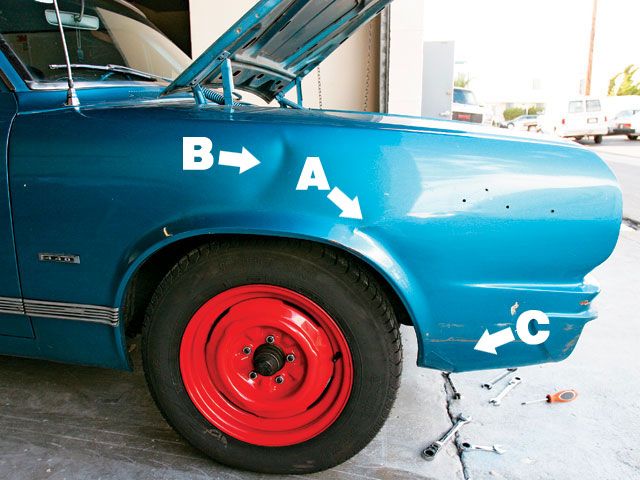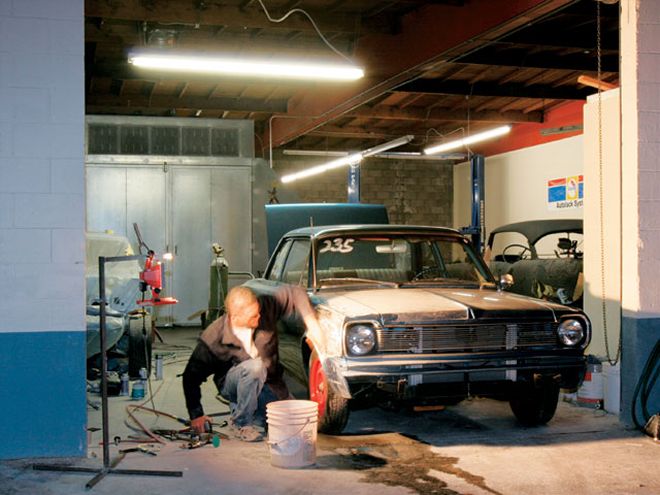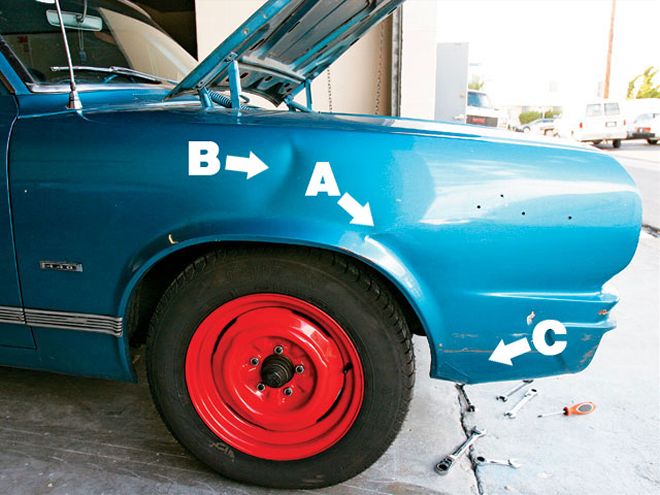
 We had to resort to the torch and anvil method to pop the crinkle and dents from the front fender. Wanna know how?
We had to resort to the torch and anvil method to pop the crinkle and dents from the front fender. Wanna know how?
For those of you who are following the CC/Rambler build ('67 Rambler American with a Jeep 360 and stock Gremlin parts), it ran an uncorrected 12.75 at 112 mph at LACR in Palmdale, California. Call it a glory run if you will because we first broke the stock rearend then shattered the overrunning clutch in the transmission when the engine was at 6,400 rpm and the tires were at zero for a millionth of a second. Fortunately, we didn't oil down the track and the Rambler made it back to the trailer in high gear and safely back to the shop. So while the transmission got a repair and a tweak from Racetrans and axles and a Sure Grip arrived from Moser, we got to fixin' dents.
To recap, before we owned it, the Rambler had been cocooned in a garage in Southern California after someone's grandmother parked the right front fender into the garage wall and simply never returned to the scene of the crime. Car Craft spelunkers excavated the prize and noticed it had been hit lightly in the right rear and repaired as well. Other than those mishaps and a few small dents and scratches from bicycles and kids, the body was in pretty good shape. We wanted to go to the paintless dent repair guys to fix the front fender, but they told us not only was the paint already cracked and flaking off but also they don't really handle metal with such a huge crease. We'd need to repair this thing the old-fashioned way, by stripping paint and panel and beating until the dent went away. Watch us play with fire and hammers.
Paper and Grit
 To the untrained eye, this looks like a wrinkle above the fender lip (A) and a pushed-in dent in the middle and lower half of the quarter (B, C). If you want to get behind the dents and force them out or grab the lower section and bend it straight, you'll never get it right. This is really one huge dent that covers the entire area rather than three separate ones, and you have to work it that way.
To the untrained eye, this looks like a wrinkle above the fender lip (A) and a pushed-in dent in the middle and lower half of the quarter (B, C). If you want to get behind the dents and force them out or grab the lower section and bend it straight, you'll never get it right. This is really one huge dent that covers the entire area rather than three separate ones, and you have to work it that way.
ToolsToolSourcePriceComplete hammer and dolly setEastwood$79.99Metal-bumping how-to bookEastwood12.996-inch DAQ random orbital sanderEastwood49.995-inch high-speed body sander (grinder)Eastwood32.9924-grit RhynoFibre 5-inch resin grinding disc, 25 packEastwood24.99Flexible sanding block, 3 packEastwood14.99Hutchins 800 orbital sanderTool Crib225.92Board-sander kitEastwood69.99Sandpaper, 8 packEastwood6.99